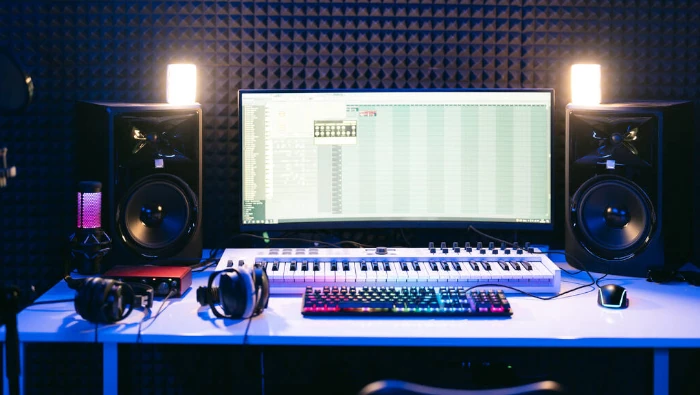Music is a powerful form of expression that can convey emotions, stories, and messages. Music can also be used for various purposes, such as entertainment, education, advertising, and social change. But how is music created? How do musicians transform their ideas into sounds that can captivate the listeners?
One of the key elements of music creation is the musical arrangement. A musical arrangement is the process of arranging and orchestrating the musical elements of a song, such as melody, harmony, rhythm, and instrumentation. A musical arrangement can enhance the original song by adding variety, contrast, and coherence. A musical arrangement can also change the style, mood, and genre of the song, making it suitable for different audiences and contexts.
But how much does it cost to produce a musical arrangement made in a recording studio, in any style? This is a question that many people have, and we will try to answer it in this blog post. The cost of producing a musical arrangement will depend on some important factors, such as:
– The creative musician: The person who is responsible for creating the musical arrangement, using his or her musical knowledge, skills, and creativity.
– The recording studio: The place where the musical arrangement is recorded, using professional equipment and software.
– The complexity of the musical arrangement: The level of difficulty and detail of the musical arrangement, involving the number and type of instruments, the harmonic structure, and the audio mixing techniques.
In this blog post, we will explore each of these factors in detail, and provide a range of prices for producing a musical arrangement. We will also give you some tips on how to find a good musical arranger who can help you achieve quality and success in your musical productions. Let’s get started!
The Creative Musician

The musical arrangement is not only a technical process, but also a creative one. The musical arranger is the person who is responsible for creating the musical arrangement, using his or her musical knowledge, skills, and creativity. The musical arranger is also a kind of composer, as he or she can add new musical elements to the original song, such as melodies, harmonies, rhythms, and interludes.
The musical arranger needs to have a good understanding of the musical genre, style, and mood of the song, as well as the intended audience and context. The musical arranger also needs to have a good communication with the songwriter, the singer, and the producer, to ensure that the musical arrangement meets their expectations and vision.
The musical arranger needs to have a good command of the keyboard, as this is the instrument that is used to control all the other instruments that make up the musical arrangement. The keyboard allows the musical arranger to play and record different sounds, such as piano, guitar, bass, drums, strings, brass, woodwinds, and synthesizers. The keyboard also allows the musical arranger to edit and modify the sounds, such as changing the pitch, volume, tone, and effects.
The musical arranger needs to have a good knowledge of music theory, as this is the foundation of the musical arrangement. Music theory involves the study of the musical elements, such as scales, chords, intervals, modes, keys, and progressions. Music theory also involves the study of the musical forms, such as verse, chorus, bridge, intro, outro, and hook. Music theory helps the musical arranger to create a coherent and harmonious musical arrangement that supports and enhances the original song.
The musical arranger needs to have a good sense of creativity, as this is the essence of the musical arrangement. Creativity involves the ability to generate new and original ideas, to combine and recombine existing ideas, and to solve problems and overcome challenges. Creativity also involves the ability to express oneself, to communicate emotions, and to evoke feelings. Creativity helps the musical arranger to create a unique and memorable musical arrangement that stands out and captivates the listeners.
The musical arranger is an important figure in the music production process, as he or she can make a significant difference in the quality and success of the musical project. Therefore, finding a good musical arranger is a crucial step for anyone who wants to produce a musical arrangement.
But how much does a good musical arranger charge for his or her services? And how can you find a good musical arranger who can meet your needs and expectations? We will answer these questions in the next sections of this blog post.
The Recording Studio

The musical arrangement is not only a creative process, but also a technical one. The recording studio is the place where the musical arrangement is recorded, using professional equipment and software. The recording studio can provide the musical arranger with the necessary tools and resources to produce a high-quality musical arrangement that sounds clear, balanced, and polished.
The recording studio can offer different services and options for producing a musical arrangement, such as:
– Renting the studio space and equipment: The musical arranger can rent the recording studio for a certain period of time and use the studio’s equipment and software to record and edit the musical arrangement. The studio may also provide an audio engineer who can assist the musical arranger with the technical aspects of the recording and editing process. The cost of renting the studio space and equipment will depend on the studio’s location, reputation, availability, and facilities. The average cost of renting a recording studio in the US is about $50 per hour, but it can vary from $20 to $200 or more per hour.
– Hiring the studio’s arranger and producer: The recording studio can also provide its own musical arranger and producer who can create the musical arrangement for the client. The studio’s arranger and producer will work with the client to understand their needs and expectations, and then create the musical arrangement according to their specifications. The cost of hiring the studio’s arranger and producer will depend on their experience, skills, and portfolio. The average cost of hiring a music producer in the US is about $500 per song, but it can vary from $100 to $10,000 or more per song.
Another possibility is to hire a freelance music arranger who can produce the musical arrangement remotely. A freelance music arranger is a self-employed musician who offers his or her services online, using their own home studio and equipment. A freelance music arranger can provide the client with more flexibility, convenience, and affordability, as they can work from anywhere, anytime, and charge lower rates than a professional recording studio. However, a freelance music arranger may also have some disadvantages, such as less reliability, quality, and security, as they may not have the same level of expertise, equipment, and software as a professional recording studio.
The cost of hiring a freelance music arranger will depend on their reputation, availability, and demand. The average cost of hiring a freelance music arranger in the US is about $300 per song, but it can vary from $50 to $1000 or more per song.
Whether you choose to rent a professional recording studio, hire a studio’s arranger and producer, or hire a freelance music arranger, you need to consider the pros and cons of each option, and find the one that suits your budget, timeline, and quality standards.
But how can you find a good recording studio or a freelance music arranger who can produce a musical arrangement for you? And how can you make the most of your recording studio experience? We will give you some tips and advice in the next sections of this blog post.
The Complexity of a Musical Arrangement

The musical arrangement is not only a technical and creative process, but also a complex one. The complexity of a musical arrangement refers to the level of difficulty and detail of the musical arrangement, involving the number and type of instruments, the harmonic structure, and the audio mixing techniques.
The complexity of a musical arrangement can affect the cost, time, and quality of the musical production, as well as the impact and appeal of the musical product. Therefore, choosing the appropriate level of complexity for a musical arrangement is an important decision that requires careful consideration and planning.
The complexity of a musical arrangement can be classified into three categories: simple, moderate, and complex.
– Simple: A simple musical arrangement is one that uses a few instruments, usually one or two, such as a guitar and a voice, or a piano and a voice. A simple musical arrangement has a basic harmonic structure, usually based on a few chords, such as I-IV-V, or I-V-vi-IV. A simple musical arrangement has a minimal audio mixing, usually involving only volume, panning, and equalization. A simple musical arrangement is easy and fast to produce, and can cost less than $100 per song. However, a simple musical arrangement may also sound plain, boring, and amateurish, and may not attract much attention or interest from the listeners.
– Moderate: A moderate musical arrangement is one that uses a moderate number of instruments, usually three to five, such as a guitar, a bass, a drum, a keyboard, and a voice. A moderate musical arrangement has a moderate harmonic structure, usually based on a few chord progressions, such as ii-V-I, or vi-ii-V-I. A moderate musical arrangement has a moderate audio mixing, usually involving some effects, such as reverb, delay, and compression. A moderate musical arrangement is moderately difficult and time-consuming to produce, and can cost between $100 and $500 per song. A moderate musical arrangement can sound balanced, pleasant, and professional, and can appeal to a wide range of listeners.
– Complex: A complex musical arrangement is one that uses a large number of instruments, usually more than five, such as a guitar, a bass, a drum, a keyboard, a voice, a string section, a brass section, a woodwind section, and a synthesizer. A complex musical arrangement has a complex harmonic structure, usually based on several chord progressions, modulations, and substitutions, such as i-VI-III-VII, or i-bII-bIII-bVII. A complex musical arrangement has a complex audio mixing, usually involving many effects, such as chorus, flanger, distortion, and automation. A complex musical arrangement is very difficult and time-consuming to produce, and can cost more than $500 per song. However, a complex musical arrangement can also sound rich, diverse, and impressive, and can captivate and inspire the listeners.
The complexity of a musical arrangement depends on the musical genre, style, and mood of the song, as well as the musical vision and goal of the songwriter, the singer, and the producer. Some musical genres, such as rock, pop, and folk, may require a moderate level of complexity, while others, such as jazz, classical, and electronic, may require a high level of complexity. Some musical styles, such as acoustic, minimalist, and lo-fi, may prefer a simple level of complexity, while others, such as orchestral, maximalist, and hi-fi, may prefer a complex level of complexity. Some musical moods, such as calm, sad, and nostalgic, may suit a simple or moderate level of complexity, while others, such as energetic, happy, and epic, may suit a moderate or complex level of complexity.
The complexity of a musical arrangement can also be influenced by some techniques for creating mental states, such as arousal, attention, emotion, and memory. These techniques can help the musical arranger to create a musical arrangement that can stimulate and engage the listeners’ minds and hearts, and make them feel and remember the musical product. Some of these techniques are:
– Arousal: Arousal is the level of excitement and alertness that the listener feels when listening to music. Arousal can be increased or decreased by changing the tempo, volume, pitch, and dynamics of the music. For example, a fast, loud, high, and varied music can increase the arousal, while a slow, soft, low, and constant music can decrease the arousal.
Arousal can also be influenced by the musical genre, style, and mood, as some of them can be more arousing or relaxing than others. For example, a rock, dance, or metal music can be more arousing, while a classical, ambient, or chillout music can be more relaxing. Arousal can affect the listener’s motivation, interest, and enjoyment of the music, as well as their physiological and psychological responses, such as heart rate, blood pressure, and mood.
– Attention: Attention is the level of focus and concentration that the listener gives to the music. Attention can be increased or decreased by changing the complexity, novelty, and contrast of the music. For example, a complex, novel, and contrasting music can increase the attention, while a simple, familiar, and similar music can decrease the attention. Attention can also be influenced by the musical genre, style, and mood, as some of them can be more attention-grabbing or attention-releasing than others. For example, a jazz, classical, or electronic music can be more attention-grabbing, while a pop, folk, or country music can be more attention-releasing. Attention can affect the listener’s comprehension, appreciation, and learning of the music, as well as their cognitive and behavioral responses, such as memory, analysis, and action.
– Emotion: Emotion is the level of feeling and expression that the listener experiences when listening to music. Emotion can be increased or decreased by changing the melody, harmony, rhythm, and instrumentation of the music. For example, a major, consonant, regular, and bright music can increase the positive emotion, while a minor, dissonant, irregular, and dark music can increase the negative emotion. Emotion can also be influenced by the musical genre, style, and mood, as some of them can be more emotional or rational than others. For example, a blues, soul, or ballad music can be more emotional, while a rap, reggae, or techno music can be more rational. Emotion can affect the listener’s empathy, identification, and expression of the music, as well as their affective and social responses, such as mood, attitude, and communication.
– Memory: Memory is the level of recall and recognition that the listener has of the music. Memory can be increased or decreased by changing the repetition, variation, and structure of the music. For example, a repeated, varied, and structured music can increase the memory, while a non-repeated, non-varied, and non-structured music can decrease the memory. Memory can also be influenced by the musical genre, style, and mood, as some of them can be more memorable or forgettable than others. For example, a pop, rock, or folk music can be more memorable, while a jazz, classical, or ambient music can be more forgettable. Memory can affect the listener’s retention, retrieval, and recognition of the music, as well as their mnemonic and semantic responses, such as association, categorization, and meaning.
The complexity of a musical arrangement is a key factor that can determine the cost, time, and quality of the musical production, as well as the impact and appeal of the musical product. Therefore, choosing the appropriate level of complexity for a musical arrangement is a crucial step that requires careful consideration and planning.
But how can you choose the best level of complexity for your musical arrangement? And how can you use the techniques for creating mental states to enhance your musical arrangement? We will give you some tips and advice in the next sections of this blog post.
How Much Does a Musical Arrangement Cost?

After learning about the creative musician, the recording studio, and the complexity of a musical arrangement, you may be wondering: how much does a musical arrangement cost? How much do you need to pay to produce a musical arrangement for your song, in any style?
The answer is: it depends. The cost of producing a musical arrangement can vary greatly, depending on several factors, such as:
– The musical arranger: The person who creates the musical arrangement, using his or her musical knowledge, skills, and creativity. The musical arranger can charge you per hour or per project, depending on their experience, reputation, and demand. The average cost of hiring a musical arranger in the US is about $300 per song, but it can range from $50 to $1000 or more per song.
– The recording studio: The place where the musical arrangement is recorded, using professional equipment and software. The recording studio can charge you per hour or per project, depending on their location, availability, and facilities. The average cost of renting a recording studio in the US is about $50 per hour, but it can range from $20 to $200 or more per hour.
– The complexity of the musical arrangement: The level of difficulty and detail of the musical arrangement, involving the number and type of instruments, the harmonic structure, and the audio mixing techniques. The complexity of the musical arrangement can affect the time and effort required to produce the musical arrangement, as well as the quality and impact of the musical product. The average cost of producing a simple musical arrangement is less than $100 per song, a moderate musical arrangement is between $100 and $500 per song, and a complex musical arrangement is more than $500 per song.
As you can see, the cost of producing a musical arrangement can vary widely, depending on the musical arranger, the recording studio, and the complexity of the musical arrangement. Therefore, it is hard to give a precise and accurate answer to the question of how much does a musical arrangement cost.
However, we can give you some general guidelines and tips on how to estimate and reduce the cost of producing a musical arrangement, such as:
– Do your research: Before you hire a musical arranger or a recording studio, do some research on their background, portfolio, and reviews. Look for samples of their previous work, and see if they match your musical genre, style, and mood. Compare their prices and services, and see if they offer any discounts or packages. Ask for references and testimonials, and see if they have any satisfied and loyal customers. Doing your research can help you find a good musical arranger or a recording studio that can meet your needs and expectations, and offer you a fair and reasonable price.
– Negotiate the terms: Once you find a musical arranger or a recording studio that you like, negotiate the terms and conditions of the contract with them. Discuss the scope, timeline, and budget of the project, and see if you can agree on a fixed or flexible price. Define the roles and responsibilities of each party, and see if you can collaborate and communicate effectively. Specify the deliverables and expectations, and see if you can request revisions and feedback. Negotiating the terms can help you avoid any misunderstandings, conflicts, and disputes, and ensure a smooth and successful musical production process.
– Optimize the process: After you start the musical production process, optimize the process and make it as efficient and effective as possible. Prepare and plan your musical ideas and materials, and share them with the musical arranger or the recording studio. Provide clear and constructive feedback and suggestions, and listen to their feedback and suggestions. Use the best tools and resources available, and make use of the techniques for creating mental states. Optimizing the process can help you save time and money, and improve the quality and impact of the musical product.
These are some general guidelines and tips on how to estimate and reduce the cost of producing a musical arrangement. However, remember that the cost of producing a musical arrangement is not the only factor that you should consider when you want to produce a musical arrangement for your song. You should also consider the value and the benefit of producing a musical arrangement, such as:
– The value of the musical arrangement: The musical arrangement is not just a cost, but also a value. The musical arrangement can add value to your original song, by enhancing its musical elements, such as melody, harmony, rhythm, and instrumentation. The musical arrangement can also add value to your musical product, by increasing its quality, appeal, and impact. The musical arrangement can also add value to your musical brand, by showcasing your musical vision, goal, and identity. The musical arrangement can also add value to your musical career, by expanding your musical skills, knowledge, and creativity. The value of the musical arrangement can outweigh the cost of producing the musical arrangement, and make it worth the investment.
– The benefit of the musical arrangement: The musical arrangement is not just a value, but also a benefit. The musical arrangement can benefit you in many ways, such as:
– It can help you express yourself, your emotions, and your messages through music, and communicate them to your listeners.
– It can help you attract and engage your listeners, and make them feel and remember your music.
– It can help you differentiate yourself from other musicians, and stand out in the competitive and crowded musical market.
– It can help you achieve your musical goals, such as releasing an album, performing a concert, or winning an award.
– It can help you enjoy and have fun with music, and make it a rewarding and fulfilling experience.
The benefit of the musical arrangement can outweigh the cost of producing the musical arrangement, and make it worth the effort.
In conclusion, the cost of producing a musical arrangement can vary greatly, depending on the musical arranger, the recording studio, and the complexity of the musical arrangement. However, the cost of producing a musical arrangement is not the only factor that you should consider when you want to produce a musical arrangement for your song. You should also consider the value and the benefit of producing a musical arrangement, and see if they outweigh the cost. Producing a musical arrangement for your song can be a great way to enhance your musical product, brand, and career, and to express, communicate, and enjoy your music.
Conclusion

In this blog post, we have learned about the musical arrangement and its importance for different purposes. We have also learned about the main factors that affect the cost of producing a musical arrangement, such as the creative musician, the recording studio, and the complexity of the musical arrangement. We have also learned about the value and the benefit of producing a musical arrangement, and how to estimate and reduce the cost of producing a musical arrangement.
We hope that this blog post has been informative and helpful for you, and that you have gained some insights and tips on how to produce a musical arrangement for your song, in any style. Producing a musical arrangement can be a challenging and rewarding process, that can enhance your musical product, brand, and career, and help you express, communicate, and enjoy your music.

